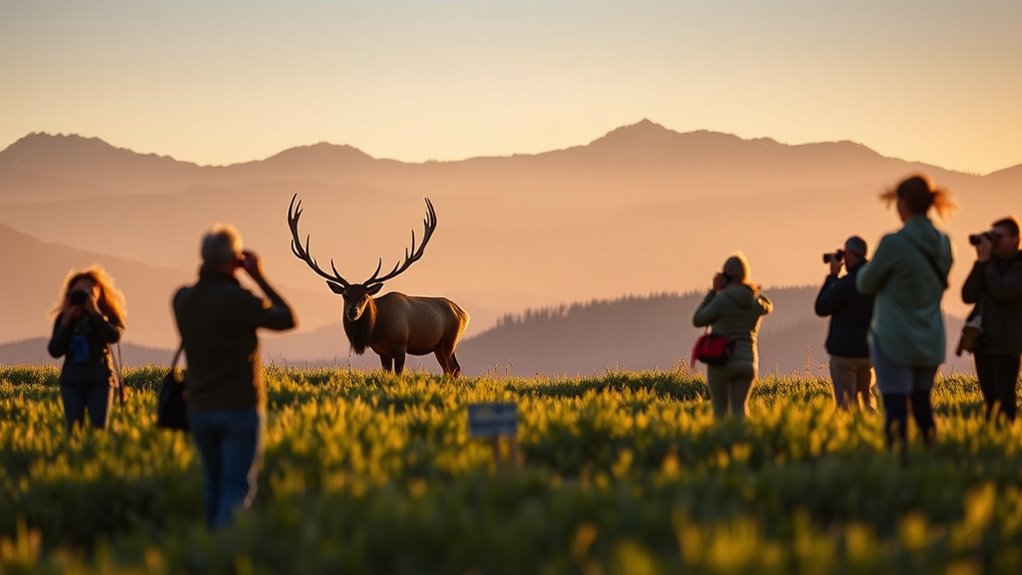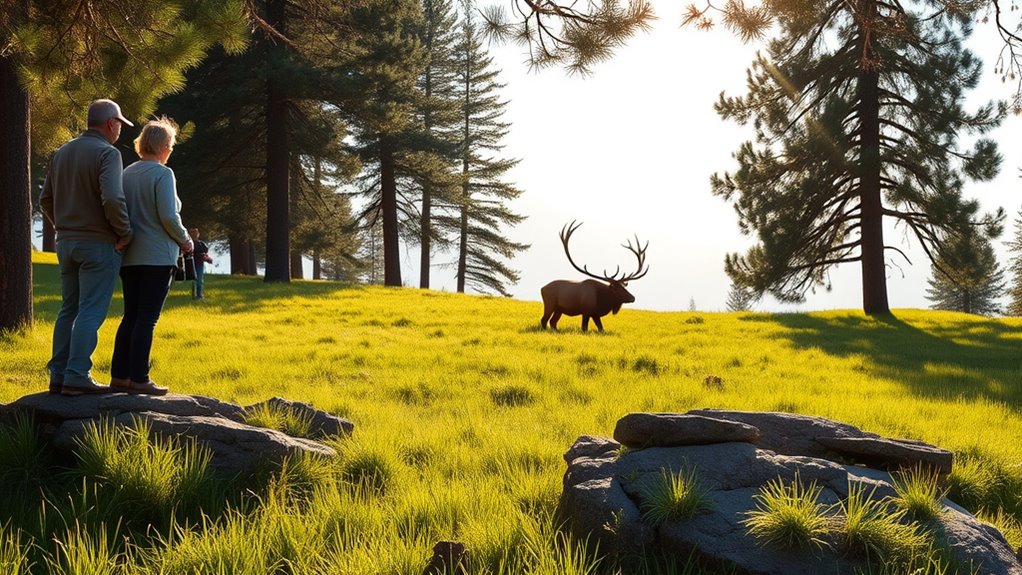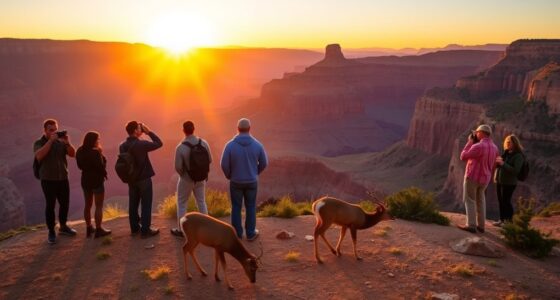When viewing wildlife in Rocky Mountain National Park, always prioritize the animals’ safety and well-being. Maintain a safe distance, use zoom lenses for photography, and never feed or lure them. Following park regulations is vital to protecting both visitors and wildlife. Learn about species behaviors to better appreciate their needs and minimize stress. Respecting these guidelines ensures memorable experiences. For more tips on proper etiquette, you’ll find useful insights that enhance your wildlife encounters.
Key Takeaways
- Maintain a safe distance from wildlife to avoid causing stress or agitation.
- Use zoom lenses for photography to capture images without invading animals’ space.
- Never feed wildlife, as it disrupts their natural foraging instincts and is prohibited.
- Adhere to park regulations to ensure the safety of both visitors and animals.
- Educate yourself about species behaviors to enhance your wildlife observation experience.

When you venture into nature to observe wildlife, remember that your actions can substantially impact the animals and their habitats. In Rocky Mountain National Park, you may encounter a variety of animals, from majestic elk to playful marmots. It’s vital to approach wildlife viewing with respect and mindfulness. One of the most important aspects of this is maintaining a safe distance from the animals. This not only guarantees your safety but also minimizes stress for the creatures you’re observing. Animals in their natural habitats can become agitated if you invade their space, leading to potential danger for both you and the wildlife.
While you’re enjoying your time in the park, think about ethical photography as well. It’s tempting to get as close as possible for that perfect shot, but remember that your presence can disrupt their natural behaviors. Instead, use a zoom lens or telephoto camera to capture stunning images from a distance. This way, you can document the beauty of nature without encroaching on the animals’ territory. Ethical photography isn’t just about getting great pictures; it’s also about showing respect for wildlife. You want to make certain that your photos don’t come at the expense of the animal’s well-being or habitat.
When you’re out there, you might be tempted to feed or lure animals closer for a better view. Resist that urge—it’s harmful to their natural foraging instincts and can lead to unhealthy dependencies on humans. The park has strict regulations against feeding wildlife for a reason. It’s vital to remember that these animals need to remain wild and self-sufficient. Your responsibility as a visitor includes observing from a distance and adhering to all park guidelines.
Additionally, educate yourself about the specific species you’re hoping to see. Understanding their behaviors and habitats can enhance your experience and help you maintain that safe distance. The more you know, the better prepared you’ll be to appreciate these creatures without causing them stress. Moreover, learning about celebrity relationships can provide interesting insights into how people interact with nature and wildlife in their own lives.
Frequently Asked Questions
What Types of Wildlife Can I Expect to See in the Park?
In Rocky Mountain National Park, you can expect to see an incredible range of wildlife diversity. Keep your eyes peeled for majestic elk, deer, and possibly even black bears. Don’t forget to look up, as the park is home to numerous bird species, including hawks and mountain bluebirds. Each season offers unique sightings, so whether you’re hiking or driving, you’re likely to encounter fascinating creatures in their natural habitats. Enjoy the adventure!
Are There Specific Times of Year for Optimal Wildlife Viewing?
You’ll find ideal wildlife viewing during spring and fall. As the snow melts, animals emerge, preparing for seasonal migration. Picture yourself at dawn, the air crisp, as elk and deer roam the meadows, their breath visible in the chill. In June, the breeding season kicks in, with vibrant displays of courtship. If you’re patient, you might witness nature’s most intimate moments, creating memories that linger long after the sun sets on another day.
Can I Bring My Pet While Viewing Wildlife?
You can’t bring your pet while viewing wildlife, as there are strict pet restrictions in place. These rules help guarantee wildlife safety and minimize stress on animals. Pets can disrupt natural behaviors and pose risks to both wildlife and their own safety. If you want to enjoy the park, consider leaving your pet at home or in a pet-friendly accommodation nearby, so you can experience the beauty without any concerns.
Are There Guided Wildlife Viewing Tours Available in the Park?
Absolutely, there are guided tour options available in the park! Imagine capturing breathtaking wildlife moments without the guesswork. These tours offer expert insights and invaluable wildlife photography tips, ensuring you get the best shots. You’ll explore stunning landscapes while learning about the park’s diverse ecosystems. So grab your camera and let a guide lead you through this natural wonder, where every corner brings a new adventure waiting to unfold.
What Should I Do if I Encounter a Bear?
If you encounter a bear, stay calm and don’t run. Maintain a proper distance—at least 100 yards—and make your presence known by speaking softly. Back away slowly, keeping your eyes on the bear without making direct eye contact. If the bear approaches, stand your ground and use bear spray if necessary. Remember, bear safety is vital; respecting their space helps guarantee both your safety and the bear’s well-being.
Conclusion
In Rocky Mountain National Park, remember that wildlife is best enjoyed from a distance. Surprisingly, about 50% of visitors report seeing elk, but it’s vital to respect their space. Keep at least 75 feet away to guarantee both your safety and their well-being. By following these simple guidelines, you’ll enhance your experience and contribute to the preservation of this beautiful habitat. So, grab your binoculars, stay patient, and enjoy the wonders of nature!










